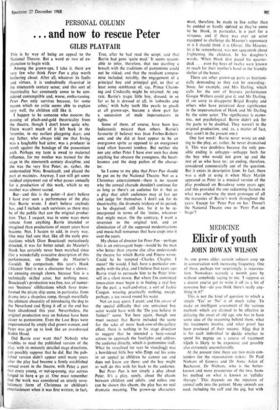Elixir of youth
MEDICINE JOHN ROWAN WILSON
As one grows older, certain subjects crop up in conversation with increasing frequency. One of these, perhaps not surprisingly, is rejuvena- tion. Nowadays scarcely a month goes by without somebody saying to me, 'I suppose as a doctor you've got to write it off as a lot of nonsense but—do you think there's really any- thing in it?'
This is not the kind of question to which a simple 'Yes' or 'No' is of much value. To make an intelligent assessment of the various methods which are claimed to be effective in delaying the onset of old age, one has to have some idea of the reasoning behind them, what the treatments involve, and what proof has been produced of their success. After that it is for each individual to decide whether to spend his menay on a course of treatment which is likely to be expensive and possibly also extremely uncomfortable.
At the present time there are two main con- tenders for the rejuvenation stakes: Dr Paul Niehans of Geneva and Dr Anna Asian of Bucharest. Dr Niehans, who is the better- known and more prosperous of the two, bases his method on what is known as 'cellular therapy.' This depends on the injection of animal cells into the patient. Many animals are used, including the calf and the pig, but with
a particular emphasis on the embryo of the sheep. The actual natwe and dosage of cells used varies from person to person, and is worked out from the clinical experience of Niehans himself, together with the results of a complex series of biochemical tests. Niehans prefers to use cells from freshly killed animals, but also claims success with cells which have been removed at an earlier date and deep- frozen. They are injected into the muscles of the thigh. The patient has to be taken into a nursing home and, because of the elaborate precautions necessary to ensure that the ani- mals used are completely healthy, the course of treatment is extremely expensive.
The expense has not acted as a deterrent on the kind of people who visit Dr Niehans's clinic. The world, after all, contains a great number of people who would regard a thousand pounds as well spent if it brought them an extra few years of active life. Famous individuals who have received the Niehans treatment include Sir Winston Churchill, Dr Adenauer, Gloria Swanson and Somerset Maugham. Most of them have expressed satis- faction with the result. However, they can hardly be regarded as a representative sample of the population. Very rich men, other things being equal, have the edge on the rest of us when it comes to staying alive, and it is also reasonable to suppose that a man who is pre- pared to undergo rejuvenation treatment is likely to take extra care of himself in other ways.
Niehans does not claim to understand exactly why his method works, though he has produced several theories, none of which fits in very convincingly with orthodox scientific knowledge. His results are not easy to assess in statistical terms. The best method of test- ing any new treatment is by means of what is known as a 'double-blind control experiment' in which patients on the treatment are com- pared with a similar series who are receiving no treatment at all, without the assessor know- ing which patients are which. Any other method of assessment is liable to error. The Niehans method has not yet been properly assessed' by double-blind trials and so it is not possible to state anything categorically about its success.
The same applies to the other popular cur- rent method devised by Dr Asian at the Parhon Institute • in Bucharest. Dr Asian's --method has the virtue of simplicity. It con- sists of serial injection into the muscles of the thigh of a solution which was first intro- duced under the slightly portentous title of H3, but later turned out to be a 2 per cent solution of the local anaesthetic novocaine. Like Dr Niehans, Dr Asian has quoted some really stunning individual case-histories. She can produce patients who look and feel better, who experience increased hair growth, and can do hand-stands at the age of a hundred. She has not, however, been equally successful in eirganisinz double-blind trials of her treatment, in spite or havirig state backing for her insti- tute. Nor has it been ptrslible, in spite of repeated attempts, to repeat her exirit•silinaly results in other centres. This fact, added to a general failure to think of any logical reason why novocaine should have any bene- ficial effect on senility, has led to scepticism about the value of the Asian treatment.
My own advice on this subject is that I don't believe in the Asian treatment, and that I am very sceptical of the Niehans treatment too, but that because of its complexity,.it has been very difficult to produce scientific evi- dence about the Niehans treatment, one way or the other. Its reputation rests on hearsay-, it hasn't been proved but its hasn't been dis- proved either. Logically, in the light of our present knowledge, it doesn't sound as if it ought to work.
There have, of course, been other methods of rejuvenation which were popular in their day. The grafting of monkey testicles had a great vogue between the wars but is now hope- lessly out of fashion. Yoghourt has had its hour of glory, and so has Royal Jelly. They were not the first, and they will not be the last. No matter how logical and scientific we may fancy ourselves to be, I imagine we all have a dream that somebody will find an elixir which will put off that dreadful day when the skin turns yellow and the joints creak and the teeth begin drop out. I'm beginning to get more interested in the subject myself every year.



































 Previous page
Previous page